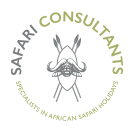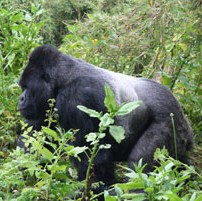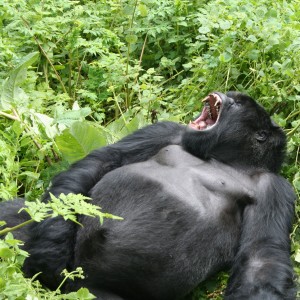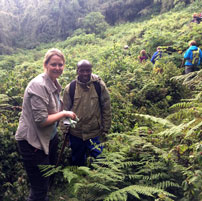An in-depth guide to gorilla tracking in Uganda & Rwanda: where to go, when to go, places to stay, what to pack, and top tips for making sure you get the most out of this unforgettable wildlife experience.
One of the most amazing wild creatures in Africa is the mountain gorilla, found in the high altitude forests of Uganda, Rwanda and The Democratic Republic of Congo. There are only just over 1000 mountain gorillas in existence, primarily located in Bwindi Impenetrable Forest in Uganda, and throughout the Virunga Volcanoes which form the border between Uganda, Rwanda and Democratic Republic of Congo. To meet these majestic creatures in their natural habitat is a true privilege, an experience that creates magical memories that last a lifetime.
UGANDA vs RWANDA
A common consideration when planning a trip to see the gorillas is which country/region to prioritise.
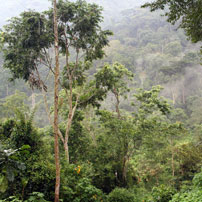 Historically, Uganda has always been well known for seeing gorillas and offered the chance to see gorillas in two destinations – the Bwindi Impenetrable Forest and the Mgahinga National Park. Both regions are in the south-west of the country, a full days drive from Uganda’s capital city Kampala, although there are now a scheduled air services to the region. Bwindi is still very much a key region to consider, but, in recent years Mgahinga has been troubled by inconsistent sightings as the family groups cross the border into Rwanda and DRC.
Historically, Uganda has always been well known for seeing gorillas and offered the chance to see gorillas in two destinations – the Bwindi Impenetrable Forest and the Mgahinga National Park. Both regions are in the south-west of the country, a full days drive from Uganda’s capital city Kampala, although there are now a scheduled air services to the region. Bwindi is still very much a key region to consider, but, in recent years Mgahinga has been troubled by inconsistent sightings as the family groups cross the border into Rwanda and DRC.
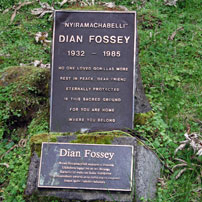 In Rwanda, the gorilla tracking industry has developed hugely over the last few years. The range of Virunga volcanoes form the Volcanoes National Park, the area made famous by researcher Dian Fossey and this area is generally regarded as the easiest option if your priority is purely seeing the gorillas rather than enjoying an extended tour of the region. Kigali, the capital, is just three hours drive south of the Virunga and with regular international flight connections, access is made very easy. In addition there are convenient flight links to key wildlife areas in neighbouring countries, in particular the Serengeti National Park in Tanzania.
In Rwanda, the gorilla tracking industry has developed hugely over the last few years. The range of Virunga volcanoes form the Volcanoes National Park, the area made famous by researcher Dian Fossey and this area is generally regarded as the easiest option if your priority is purely seeing the gorillas rather than enjoying an extended tour of the region. Kigali, the capital, is just three hours drive south of the Virunga and with regular international flight connections, access is made very easy. In addition there are convenient flight links to key wildlife areas in neighbouring countries, in particular the Serengeti National Park in Tanzania.
In the Virunga (Volcanoes National Park), the tracking itself is also generally considered a little easier than it is in Bwindi Impenetrable Forest, again suiting the slightly less adventurous traveller.
One would think from the above that Rwanda is therefore the logical choice but Uganda has several other factors going for it. Firstly, the cost of gorilla permits significantly cheaper (US$700 per day as opposed to US$1500 per day in Rwanda). Secondly, Bwindi is stunningly beautiful and as a ‘forest’ is worth visiting alone even if you do not track for gorillas. Lastly, as a country, Uganda offers more ‘safari’ variety including big game and scenic highlights such as Murchison Falls and Queen Elizabeth National Park.
In summary, Rwanda is well suited to a relatively ‘quick’ visit to see the gorillas, and better suited to travellers who are apprehensive about the physical requirements of gorilla tracking. However, Uganda tends to attract people who are slightly more adventurous and interested in value for money as well as a more in-depth look at the region, combining the gorilla tracking with other primate viewing (chimps etc), birding, walking, culture, game-viewing and general sight-seeing.
Assuming you are being hosted by a local company, you will be transferred from your overnight accommodation to the park headquarters for the 07h00 registration (your safari guide can have a hand in this if you want to track to a particular group). Here you will be assigned your gorilla group and will be given a briefing by the Park Ranger who will lead your group (usually no more than eight people will be assigned to any individual gorilla family).
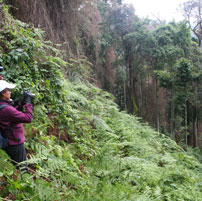 You will then drive (or in some cases walk) to the locality where your assigned gorilla family has its territory, and begin tracking. Porters can be hired to carry your day pack and they will usually be able to supply roughly-hewn walking sticks (if required).
You will then drive (or in some cases walk) to the locality where your assigned gorilla family has its territory, and begin tracking. Porters can be hired to carry your day pack and they will usually be able to supply roughly-hewn walking sticks (if required).
Walking to locate the gorillas can take between 30 minutes and 6 hours – nothing is guaranteed! Scouts will have gone ahead to find the previous night’s nesting site, and will start tracking the group from there, communicating with your park ranger by radio. Once you catch up with the gorillas (not 100% guaranteed, but it is rare to fail) you are allowed one hour with them.
There are strict rules of behaviour, such as not using flash 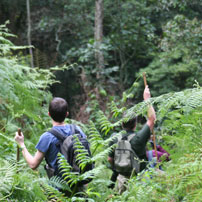 photography or approaching too close, which will be covered in your briefing. However, the gorillas themselves do not understand the rules and sometimes wander very close – seeing a powerful silverback close up is an exhilarating experience! When your hour is up you retreat out of the forest and return to your hotel, usually arriving back in time for a late lunch. The average amount of time tracking is about 4-5 hours, but it can be much longer.
photography or approaching too close, which will be covered in your briefing. However, the gorillas themselves do not understand the rules and sometimes wander very close – seeing a powerful silverback close up is an exhilarating experience! When your hour is up you retreat out of the forest and return to your hotel, usually arriving back in time for a late lunch. The average amount of time tracking is about 4-5 hours, but it can be much longer.
Consider buying at least two permits allowing you to track on at least two separate days (there is only 1 visit to each group per day). You only get one hour with the gorillas (which equates to one permit) so giving yourself two opportunities will not only double your chances of having an incredible encounter, but will also give you the chance to view more individuals and a broader range of behaviour. The weather is unpredictable so you could track one day in pouring rain, whilst the next morning has brilliant sunshine. Similarly, if the gorillas are moving, your sighting may be more challenging than if they are resting up.
It is entirely possible to combine Rwanda’s Virunga Volcanoes and Uganda’s Bwindi Impenetrable Forest on the same holiday – the areas are less than a day’s drive apart and the ultimate gorilla safari would include both!
Take a pair of leather gardening gloves to wear when tracking through thick vegetation – it enables you to grab hold of vegetation as required without worry of insects or nettles.
KEY FACTS TO REMEMBER
- You must be 15 years or older to track the gorillas
- You are not allowed to track gorillas if you have an ailment such as a cold, cough, fever, flu etc.
- Flash photography is forbidden
- A limited number of gorilla permits are available each day, for high season it is necessary to book well in advance
WHEN TO SEE THE GORILLAS
Gorilla tracking is available all year round, though conditions are arguably a little more pleasant from January to March and then from late May to September. Uganda and Rwanda both experience two main rainy seasons each year, usually April/ May and mid-October to mid-December. However it can rain at any time in the gorilla regions – this is after all an area of equatorial rainforest. In terms of finding the gorillas, in Rwanda the gorilla families are usually located lower down the Virunga slopes during or shortly after the wet season, where they feed on the fresh bamboo shoots.
PLACES TO STAY
In Rwanda there are numerous accommodation options around the town of Musanze (formerly known as Ruhengeri) and the village of Kinigi, close to the park headquarters. In Uganda, Bwindi can be accessed at various different points, and habituated gorilla families are found in various locations around the edge of the forest. The most comfortable accommodation options are found around the village of Buhoma in the west, and Nkuringo in the south.
WHAT TO PACK AND WEAR WHEN GORILLA TRACKING
(This information also applies to Golden Monkey Tracking and Volcano climbing)
For tracking in both countries, it is worthwhile being prepared and we would suggest the following equipment:
- Good quality, preferably gore-tex (or similarly waterproof) hiking boots. Trainers are definitely not sufficient (except in emergency!). The best type of boots would be semi-stiff breathable gore-tex style with ankle support. Hard, leather boots are okay, but tend to be heavier and less breathable. ‘Waterproof’ is vital for gorilla tracking as the conditions can be very wet, even if you don’t actually step in any water.
- Trekking socks, long trousers for walking in, a long sleeve shirt for walking in (NOT COTTON). These clothes do not need to be particularly warm, but it is important to ‘cover up’ mainly to avoid biting insects, stinging nettles etc.
- Rain gear – top with hood essential (bottoms optional). You must expect some rain while you are tracking the gorillas, so a good rain jacket with a hood is a necessity. Lightweight waterproof trousers can be helpful if you experience heavy rain, but are not essential.
- Gaiters/spats can be very useful – these are waterproof sections that you attach to your leg between your boot and below your knee. They are useful for keeping mud and moisture away from your socks and lower trousers.
- Day pack to carry any valuables, camera, waterproof clothes etc. You should also take waterproof bags for protection of camera gear etc.
- Water bottle(s) – it is very important to take enough water with you. If you don’t have a water bottle, then buy bottles at your accommodation.
- Rain/ sun hat of some kind. Waterproof hat may not be needed if your waterproof jacket has a good hood, but it always helps if you have a hat or cap and you need to protect yourself from the sun anyway.
- Leather gardening or similar gloves to wear whilst walking (in case you need to grab hold of vegetation)
- Walking sticks – optional, can be provided locally if needed.
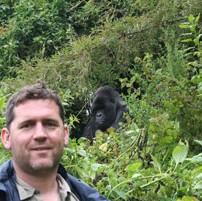 Please note that gorilla tracking is unpredictable and seeing the gorillas is not guaranteed. Though the average walking time may be only three or four hours, you should be prepared to walk for up to six or seven hours or so if necessary. The tracking can also be strenuous and far from straight-forward! If you do not walk long distances regularly, it will be worth doing a bit of training. Not only will you be climbing but the altitude at which the tracks take place will be upwards of 7000ft.
Please note that gorilla tracking is unpredictable and seeing the gorillas is not guaranteed. Though the average walking time may be only three or four hours, you should be prepared to walk for up to six or seven hours or so if necessary. The tracking can also be strenuous and far from straight-forward! If you do not walk long distances regularly, it will be worth doing a bit of training. Not only will you be climbing but the altitude at which the tracks take place will be upwards of 7000ft.
Read our trips report on gorilla tracking for firsthand accounts from our team:
Contact Us for more information on gorilla tracking. One of our safari specialists would be happy to talk your through the options available in Uganda & Rwanda.
